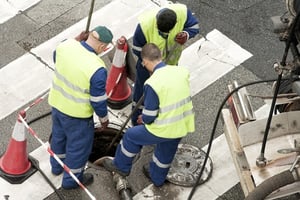Conduit Asset Management (Part 3): Violations in Manholes & Handholes
 In this four-part series, we are uncovering manhole and handhole conditions. In our experience, asset owners are often surprised at the amount of damage, trespass, and violations found in underground spaces without regular inventories. The first article in the series covered unauthorized trespassers in manholes and handholes, and the second article talked about structural damage. Both of these underground issues are a direct cause of violations, which we will be covering here.
In this four-part series, we are uncovering manhole and handhole conditions. In our experience, asset owners are often surprised at the amount of damage, trespass, and violations found in underground spaces without regular inventories. The first article in the series covered unauthorized trespassers in manholes and handholes, and the second article talked about structural damage. Both of these underground issues are a direct cause of violations, which we will be covering here.
There are three main causes for violations: damage, trespass, and third-party contractors.
Watch the video below to learn about violations.
Based on our own experience from auditing Tier 1 conduit spaces, the three most common violations are illegally moving conduit in handholes, and improper core-drilling and uncapped knockouts in manholes.
Moving Conduit
Improper Core-Drilling
Uncapped Knockouts
Other Common Violations
A few other examples of violations in manholes include:
- Incorrect racking: third-parties may leave unracked cables and splice cases hanging around the manhole space
- Not racking: sometimes third-parties leave cables and wires on the ground
- Excessive inner-duct: contractors or trespassers may leave too much inner-duct in the vault, cluttering up the space for future workers
Manhole spaces are small. Leaving unracked cables on the floor or in inappropriate spaces, leaving excessive inner-duct, or illegally moving conduit, can cause serious safety hazards for techs and maintenance crews.
Bad practices accrue out-of-sight and out-of-mind to asset owners. Ongoing damage and violations add up. Safety and vault access must work in tandem. Unsafe conditions limit contractor and technician access to vaults, while safe conditions encourage proper service maintenance. Take a look at our next article to learn more about safety and vault access. In the meantime, share your thoughts about underground conduit in the comments below.
